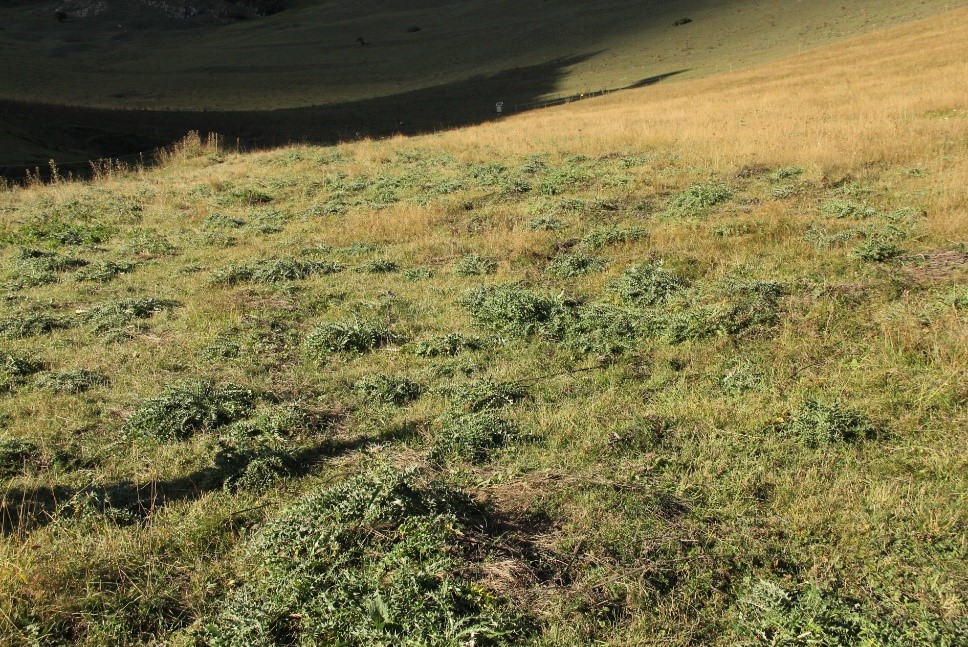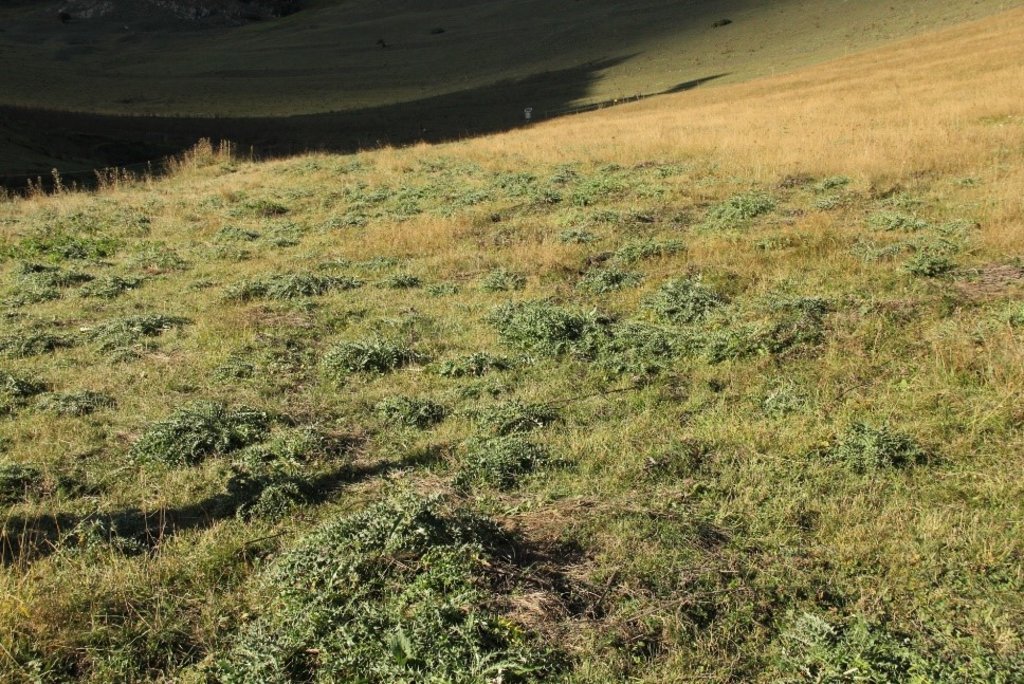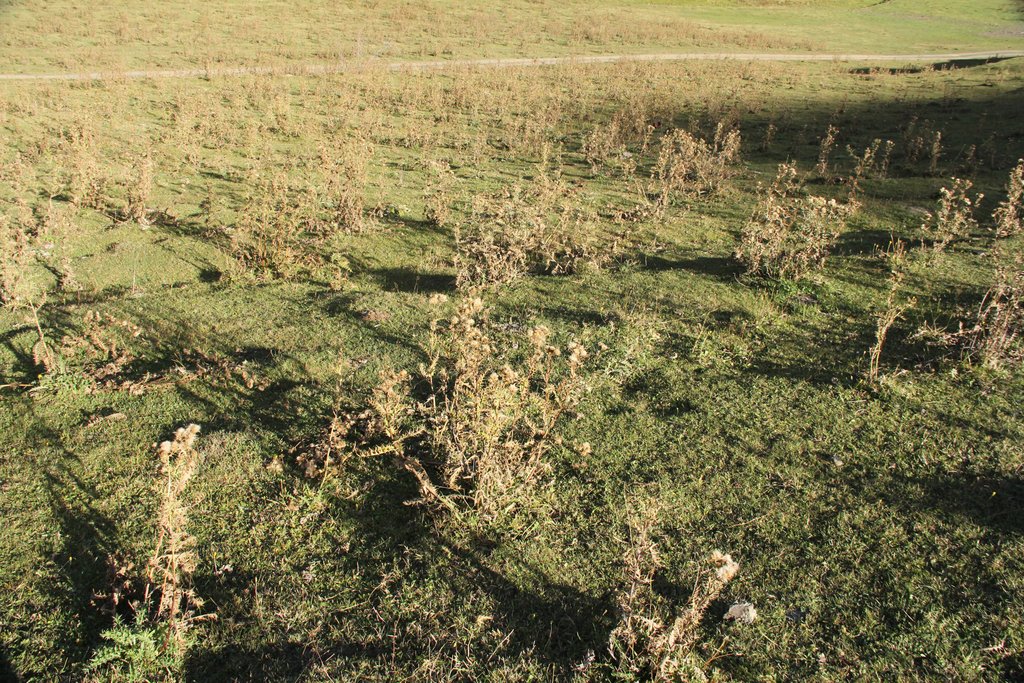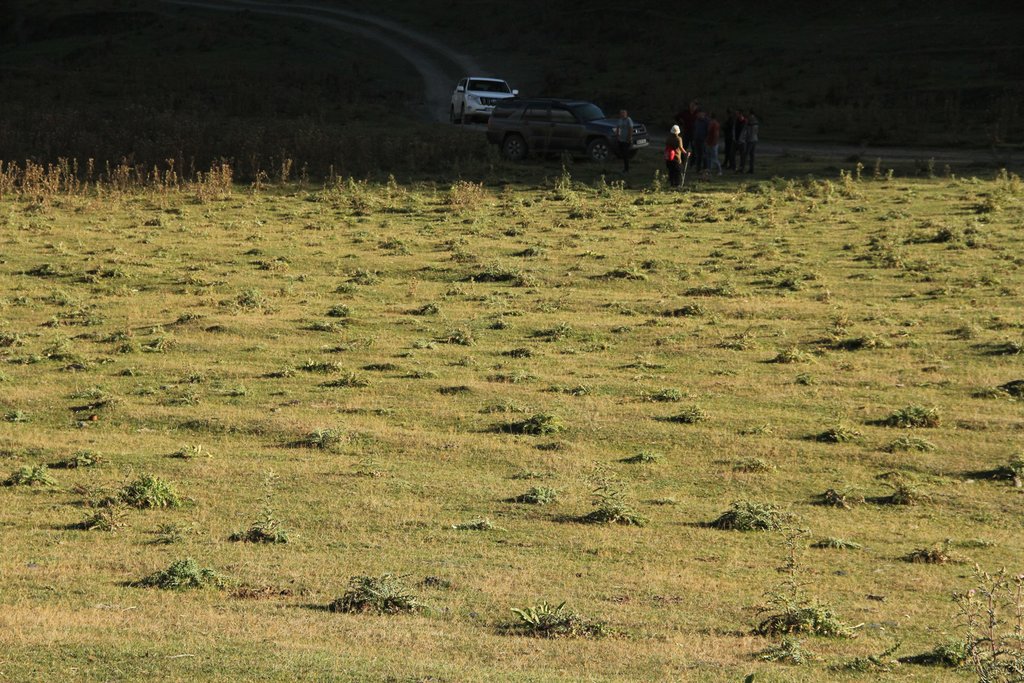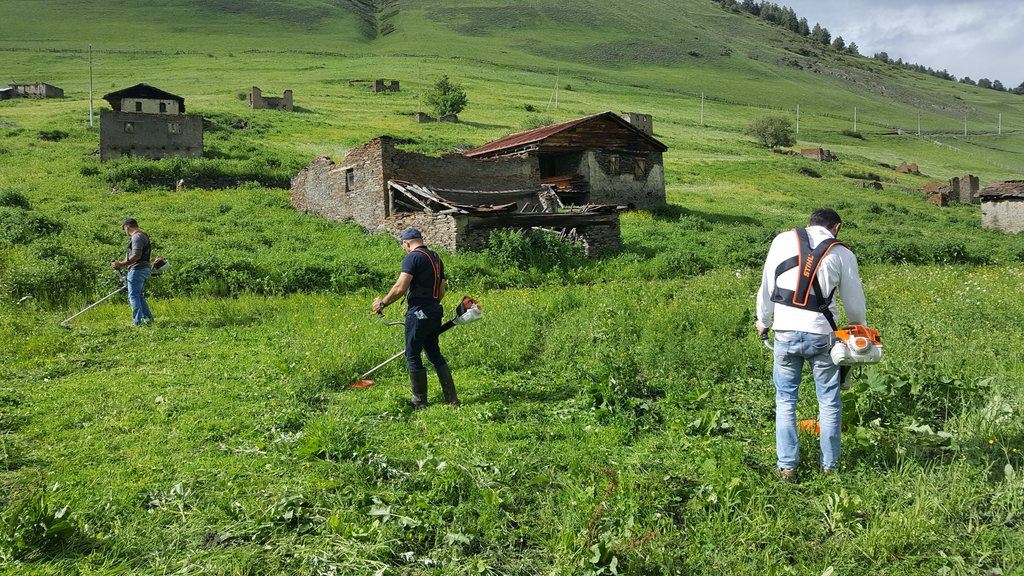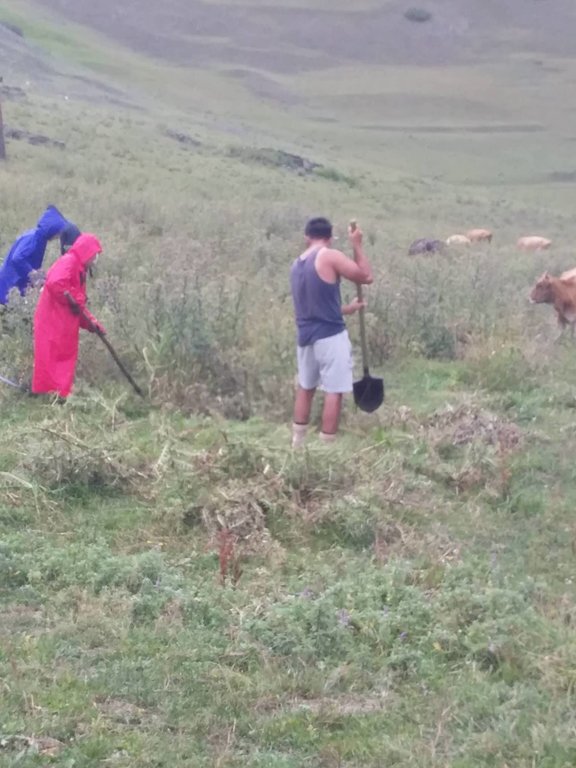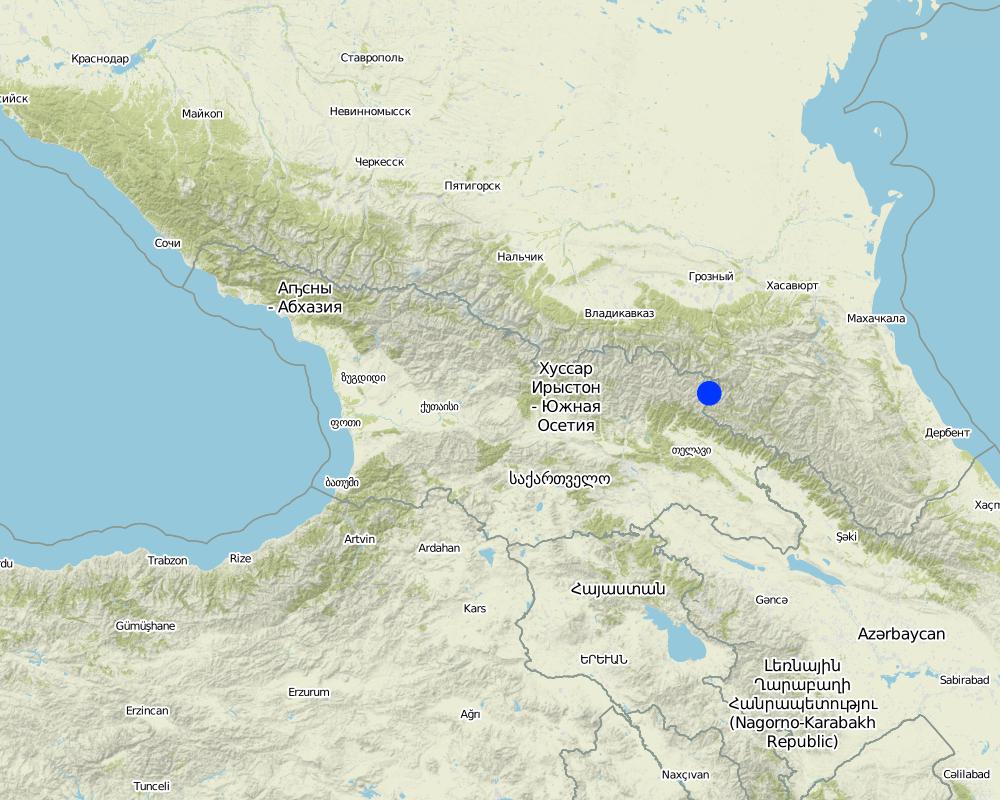Pasture-weed control by thistle cutting [乔治亚]
- 创建:
- 更新:
- 编制者: Hanns Kirchmeir
- 编辑者: Kety Tsereteli
- 审查者: Ursula Gaemperli
technologies_4273 - 乔治亚
查看章节
全部展开 全部收起1. 一般信息
1.2 参与该技术评估和文件编制的资源人员和机构的联系方式
co-compiler:
有助于对技术进行记录/评估的项目名称(如相关)
Applying Landscape and Sustainable Land Management (L-SLM) for mitigating land degradation and contributing to poverty reduction in rural area (L-SLM Project)有助于对技术进行记录/评估的机构名称(如相关)
Regional Environmental Centre for the Caucasus (REC Caucasus) - 乔治亚1.3 关于使用通过WOCAT记录的数据的条件
编制者和关键资源人员接受有关使用通过WOCAT记录数据的条件。:
是
1.4 所述技术的可持续性声明
这里所描述的技术在土地退化方面是否存在问题,导致无法被认为是一种可持续的土地管理技术?:
否
注释:
The applied technology avoids the application of chemicals by mechanical weed removal.
1.5 参考关于SLM方法(使用WOCAT记录的SLM方法)的调查问卷
2. SLM技术的说明
2.1 技术简介
技术定义:
Thistles invaded massively into village pasture land at 1800m elevation in the Caucasus. By cutting the thistles with a motor-cutter the cover of thistles have been reduced.
2.2 技术的详细说明
说明:
The technology was applied in flat sub-alpine pasture land at an elevation of about 1800 m in the village of Shenako in the Tusheti Protected Landscape, Georgia. Precipitation is 750-900mm and mean annual temperature is 2-4°C. Thistles (Cirsium sp.) were invading especially in those sections of the pasture that are rich in nutrients and have medium soil water content. This site conditions can be found mainly at the valley bottom.
There are no big machines available in this mountain villages. So the removal was done by motor-cutters. In this particular case STIHL petrol brush cutters were used with a 3 blade bush knife.
The removal of the thistles, which were covering up to 20% of the pasture land will increase the productivity of valuable fodder grass and herbs. The thistles are growing up to 1m height and taking up significant amount of nutrients from the soil and are shading other grass and herbs in their neighborhood. Because of their spices they are not eaten by cows or sheep, while the grazing pressure is increasing on the remaining grass and herb species. This leads to positive selection of thistles and a permanent increase of the thistles number and biomass in comparison to the high quality fodder plants.
The thistles have been cut in mid-June/beginning of July just at the begin of blossom. At this stage, the thistles mobilized most of the nutrients from their root system and spent them in leaf and blossom biomass. By cutting the thistles at this time, the highest impact on the nutrient balance can be reached and no new seeds will be produced in this year. It was observed, that the thistles have been eaten by the livestock when it was cut and dried up.
The motor brush cutter increases significantly the speed of cutting the thistles compared to hand scythe. The thistle has a powerful root system and is re-sprouting from the roots within the same summer. So it is important to repeat the cutting 2-3 times a year and to continue several years until the amount of thistles is permanently reduced.
The reduction of thistles will give more space, nutrients and moisture to other fodder plants and increase the productivity of the pasture land.
The challenge is the coordination of the work load within the users of the community pasture land. It needs a (written) agreement to share the workload for pasture maintenance between the families according to their number of livestock.
2.3 技术照片
关于照片的一般说明:
The photos are showing the state of the pastures before and 2 months after the application of the technology.
2.4 技术视频
注释、简短说明:
No video available
2.5 已应用该技术的、本评估所涵盖的国家/地区/地点
国家:
乔治亚
区域/州/省:
Kakheti
有关地点的进一步说明:
Shenako
具体说明该技术的分布:
- 均匀地分布在一个区域
如果技术均匀分布在一个区域,则指定覆盖的区域(单位为平方千米):
0.02
如果不知道精确的区域,请注明大致覆盖的区域:
- < 0.1 平方千米(10 公顷)
技术现场是否位于永久保护区?:
是
如果是,请具体说明:
The village of Shenako is located in the Tusheti Protected Landscape. This category is managed by the Municipality of Akhmeta.
注释:
The number of families using the village pastureland for their livestock has decreased during the last decades. In former times the 200 ha of open land around the village was used as arable land and hay meadows and the livestock was grazed on remote pastures.
Map
×2.6 实施日期
注明实施年份:
2018
2.7 技术介绍
详细说明该技术是如何引入的:
- 通过项目/外部干预
注释(项目类型等):
The weed control was funded and applied within a GEF Projected coordinated by REC Caucasus ("Applying Landscape and Sustainable Land Management (L-SLM) for mitigating land degradation and contributing to poverty reduction in rural areas"). It can be assumed, that there have been community based regulation on pasture maintenance before the Soviet period, but this regulations have not been re-established after this period.
3. SLM技术的分类
3.1 该技术的主要目的
- 改良生产
- 减少、预防、恢复土地退化
- 创造有益的经济影响
3.2 应用该技术的当前土地利用类型
同一土地单元内混合使用的土地::
否

牧场
粗放式放牧:
- 季节性迁移的放牧主义
动物类型:
- 牛 - 奶制品
- 马
- 绵羊
是否实行作物与牲畜的综合管理?:
否
产品和服务:
- 肉类
- 奶类
品种:
牛 - 奶制品
计数:
70
品种:
绵羊
计数:
400
品种:
马
计数:
30
品种:
牛 - 非奶牛牛肉
计数:
35
注释:
The area of implementation is community pasture land.
3.3 由于技术的实施,土地使用是否发生了变化?
由于技术的实施,土地使用是否发生了变化?:
- 否(继续问题3.4)
3.4 供水
该技术所应用土地的供水:
- 雨养
3.5 该技术所属的SLM组
- 畜牧业和牧场管理
3.6 包含该技术的可持续土地管理措施

管理措施
- M5:物种组成的控制/变化
注释:
The technology aims to reduce the amount of thistles in the species composition of the pasture.
3.7 该技术强调的主要土地退化类型

生物性退化
- Bs:质量和物种组成/多样性的下降
注释:
The degradation of the pastures is driven by the spreading of thistles. This process leads to a reduction of plant-diversity (shading) and fodder production.
3.8 防止、减少或恢复土地退化
具体数量名该技术与土地退化有关的目标:
- 减少土地退化
注释:
Cutting thistles is an measure for weed-control and reduces the risk of overgrazing be increasing the available area and amount of fodder plants.
4. 技术规范、实施活动、投入和成本
4.1 该技术的技术图纸
技术规范(与技术图纸相关):
The activity was applied on two plots. Plot 6 is 0.7 ha of size and located in the unfenced area. Plot 7 is 1.3 ha of size and located inside an electric fence. The hatched area (8) is indicating the fenced area.
作者:
Hanns Kirchmeir
日期:
20/03/2019
4.2 有关投入和成本计算的一般信息
具体说明成本和投入是如何计算的:
- 每个技术区域
注明尺寸和面积单位:
2 ha
具体说明成本计算所用货币:
- 美元
4.3 技术建立活动
| 活动 | 时间(季度) | |
|---|---|---|
| 1. | Prepare machinery and organize people | June |
| 2. | Select pasture plots were the measure will be applied | June |
| 3. | Cut the thistles on the selected pasture plots | End of June - Mid of July |
注释:
When working with a hand-held brush cutter it is recommended to start in those areas with less thistles and work into the direction of dense thistle stands. When working with a tractor or a sickle bar mower it is more efficient to apply the activity in dens thistle stands.
4.4 技术建立所需要的费用和投入
| 对投入进行具体说明 | 单位 | 数量 | 单位成本 | 每项投入的总成本 | 土地使用者承担的成本% | |
|---|---|---|---|---|---|---|
| 劳动力 | Selection of sites, preparation of materials and people | person-days | 3.0 | 37.0 | 111.0 | |
| 劳动力 | Labour for cutting thistles on 2 ha | person-days | 10.0 | 20.0 | 200.0 | |
| 设备 | High quality brush cutter | pieces | 1.0 | 800.0 | 800.0 | |
| 设备 | Patrol (20l) and diesel (30l) for brush cutter (6 days, 8h/day, 1l/h) | liter | 50.0 | 1.0 | 50.0 | |
| 技术建立所需总成本 | 1161.0 | |||||
| 技术建立总成本,美元 | 1161.0 | |||||
如果土地使用者负担的费用少于100%,请注明由谁负担其余费用:
The equipment (brush cutters) and labour costs have been carried by international project (GIZ-IBiS Program, GEF funded SML Project)
4.5 维护/经常性活动
| 活动 | 时间/频率 | |
|---|---|---|
| 1. | Repeat cutting of thistles 2x per year | June/July and September |
4.6 维护/经常性活动所需要的费用和投入(每年)
| 对投入进行具体说明 | 单位 | 数量 | 单位成本 | 每项投入的总成本 | 土地使用者承担的成本% | |
|---|---|---|---|---|---|---|
| 劳动力 | labour for cutting thistles (2ha) | person-days | 6.0 | 20.0 | 120.0 | 100.0 |
| 设备 | Patrol for brush cutter | liter | 96.0 | 1.0 | 96.0 | |
| 技术维护所需总成本 | 216.0 | |||||
| 技术维护总成本,美元 | 216.0 | |||||
注释:
The ongoing maintenance has to be covered by the local farmers
4.7 影响成本的最重要因素
描述影响成本的最决定性因素:
The investment in the brush cutter will only pay off if large parts of pastures are managed.
5. 自然和人文环境
5.1 气候
年降雨量
- < 250毫米
- 251-500毫米
- 501-750毫米
- 751-1,000毫米
- 1,001-1,500毫米
- 1,501-2,000毫米
- 2,001-3,000毫米
- 3,001-4,000毫米
- > 4,000毫米
指定年平均降雨量(若已知),单位为mm:
850.00
有关降雨的规范/注释:
Main rainfall in spring and autumn, July and August is the dry season.
注明所考虑的参考气象站名称:
Data from CHELSA.ORG
农业气候带
- 半湿润
Because of low annual temperature (2-4°C) the evapotranspiration is low and most of the year there is no water shortage. But in August and September drought can occur.
5.2 地形
平均坡度:
- 水平(0-2%)
- 缓降(3-5%)
- 平缓(6-10%)
- 滚坡(11-15%)
- 崎岖(16-30%)
- 陡峭(31-60%)
- 非常陡峭(>60%)
地形:
- 高原/平原
- 山脊
- 山坡
- 山地斜坡
- 麓坡
- 谷底
垂直分布带:
- 0-100 m a.s.l.
- 101-500 m a.s.l.
- 501-1,000 m a.s.l.
- 1,001-1,500 m a.s.l.
- 1,501-2,000 m a.s.l.
- 2,001-2,500 m a.s.l.
- 2,501-3,000 m a.s.l.
- 3,001-4,000 m a.s.l.
- > 4,000 m a.s.l.
说明该技术是否专门应用于:
- 凹陷情况
关于地形的注释和进一步规范:
The most dense thistle populations are observed on the flat valley floors and concave depressions at the slopes where the soil is rich in nutrients and has well balanced soil moisture.
5.3 土壤
平均土层深度:
- 非常浅(0-20厘米)
- 浅(21-50厘米)
- 中等深度(51-80厘米)
- 深(81-120厘米)
- 非常深(> 120厘米)
土壤质地(表土):
- 中粒(壤土、粉土)
- 细粒/重质(粘土)
土壤质地(地表以下> 20厘米):
- 中粒(壤土、粉土)
- 细粒/重质(粘土)
表土有机质:
- 中(1-3%)
如有可能,附上完整的土壤描述或具体说明可用的信息,例如土壤类型、土壤酸碱度、阳离子交换能力、氮、盐度等。:
Detailed soil data not available.
5.4 水资源可用性和质量
地下水位表:
< 5米
地表水的可用性:
好
水质(未处理):
不良饮用水(需要处理)
水质请参考::
地下水和地表水
水的盐度有问题吗?:
否
该区域正在发生洪水吗?:
否
关于水质和水量的注释和进一步规范:
Only in years with low precipitation there is water shortage in August and September.
5.5 生物多样性
物种多样性:
- 中等
栖息地多样性:
- 低
关于生物多样性的注释和进一步规范:
The high grazing pressure leads to medium plant species diversity.
5.6 应用该技术的土地使用者的特征
定栖或游牧:
- 半游牧的
生产系统的市场定位:
- 生计(自给)
非农收入:
- 低于全部收入的10%
相对财富水平:
- 平均水平
个人或集体:
- 个人/家庭
- 团体/社区
机械化水平:
- 手工作业
- 机械化/电动
性别:
- 女人
- 男人
说明土地使用者的其他有关特征:
The village is only occupied during summer time (June-September). One of the farmers stays in the village during winter time.
5.7 应用该技术的土地使用者使用的平均土地面积
- < 0.5 公顷
- 0.5-1 公顷
- 1-2 公顷
- 2-5公顷
- 5-15公顷
- 15-50公顷
- 50-100公顷
- 100-500公顷
- 500-1,000公顷
- 1,000-10,000公顷
- > 10,000公顷
这被认为是小规模、中规模还是大规模的(参照当地实际情况)?:
- 中等规模的
注释:
The community pasture land is around 200 ha. This area is shared by 4-6 households with livestock (sheep, cattle). Some view more families bring some horses up to Shenako during summer months.
5.8 土地所有权、土地使用权和水使用权
土地所有权:
- 社区/村庄
土地使用权:
- 自由进入(无组织)
用水权:
- 自由进入(无组织)
土地使用权是否基于传统的法律制度?:
否
注释:
The pasture land is in municipal land and managed by the community.
5.9 进入服务和基础设施的通道
健康:
- 贫瘠
- 适度的
- 好
教育:
- 贫瘠
- 适度的
- 好
技术援助:
- 贫瘠
- 适度的
- 好
就业(例如非农):
- 贫瘠
- 适度的
- 好
市场:
- 贫瘠
- 适度的
- 好
能源:
- 贫瘠
- 适度的
- 好
道路和交通:
- 贫瘠
- 适度的
- 好
饮用水和卫生设施:
- 贫瘠
- 适度的
- 好
金融服务:
- 贫瘠
- 适度的
- 好
注释:
Most important of-farm income is tourism (guesthouses, crafts).
6. 影响和结论性说明
6.1 该技术的现场影响
社会经济效应
生产
饲料生产
注释/具体说明:
By reduction of thistles the space for other plant species has increased.
对现场影响的评估(测量)进行具体说明:
The impact of the weed control on the productivity will increase when the vitality of thistles will be further reduced by frequently repetition of cutting.
6.2 该技术的场外影响已经显现
对场外影响(测量)的评估进行具体说明:
The dissemination of thistles seeds in the surrounding areas is reduced, when thistles are cut before blossom.
6.3 技术对渐变气候以及与气候相关的极端情况/灾害的暴露和敏感性(土地使用者认为的极端情况/灾害)
注释:
These sites at the valley bottom have high soil moisture content and did not show significant impact of climate change in the last decade.
6.4 成本效益分析
技术收益与技术建立成本相比如何(从土地使用者的角度看)?
短期回报:
轻度消极
长期回报:
积极
技术收益与技术维护成本/经常性成本相比如何(从土地使用者的角度看)?
短期回报:
中性/平衡
注释:
The productivity of the pastureland is 2-3t/ha per year. The removal of thistles can lead on the long term to an increase of fodder by 20% (400-600kg/ha per year). This is equivalent to 15-20 hay-bales a 3 USD (total 45-60 USD/ha and year). The amount of time for cutting the thistles and the needed patrol will decrease when during the next years so a positive balance between investment and return is expected.
6.5 技术采用
- 单例/实验
在所有采用这项技术的人当中,有多少人是自发的,即未获得任何物质奖励/付款?:
- 0-10%
注释:
It will take 2-3 years to show the full success of the measure. It needs a to negotiate new regulations on village level to agree on how to share the workload for pasture maintenance between the households according to the number of cattle.
6.6 适应
最近是否对该技术进行了修改以适应不断变化的条件?:
否
6.7 该技术的优点/长处/机会
| 土地使用者眼中的长处/优势/机会 |
|---|
| Decreasing the cost for maintanace of cattle |
| Reducing the working hours |
| Improving the pastures via weed control |
| 编制者或其他关键资源人员认为的长处/优势/机会 |
|---|
| Easy to apply, no specific skills needed |
| Visible impact within a few years |
6.8 技术的弱点/缺点/风险及其克服方法
| 土地使用者认为的弱点/缺点/风险 | 如何克服它们? |
|---|---|
| Irresponsibility of some members of the community during the maintenance of el-fence |
| 编制者或其他关键资源人员认为的弱点/缺点/风险 | 如何克服它们? |
|---|---|
| No responsibility within the community pasture land for maintenance of pasture land. | A new regulation on how to share the workload of pasture maintenance could be negotiated between villagers. |
| Machinery is expensive. | The investment will pay off when the measures are applied to the entire pasture land (100-200 ha). |
7. 参考和链接
7.1 信息的方法/来源
- 实地考察、实地调查
2 times. On before and on after implementation
- 与SLM专业人员/专家的访谈
1 (the national field expert)
- 根据报告和其他现有文档进行编译
Project report from SLM expert
(现场)数据是什么时候汇编的?:
12/09/2018
7.4 一般注释
REC Caucasus was implementing the project in close cooperation with the Protected Landscape Administration at the Municipality.
A cost-benefit analysis is planned to be prepared in the next phase
链接和模块
全部展开 全部收起链接
无链接
模块
无模块


